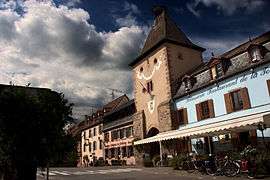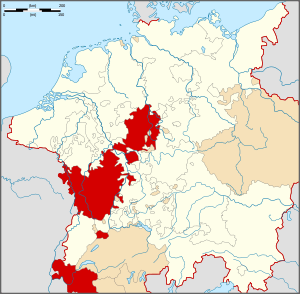Turckheim
Turckheim (Alsatian: Tercka ; German: Türkheim) is a commune in the Haut-Rhin department in Grand Est in north-eastern France. It lies west of Colmar, on the eastern slopes of the Vosges mountains.
Places of interest
Turckheim, located in Alsace, is a village known for its Gewürztraminer wines, traditional Alsatian cuisine, and stunning surrounding scenery.
Turckheim is probably most well known for its surrounding medieval wall. The wall has three doors, or portes: The Munster Door, which opens into the Munster Valley; The Door of the Brand, which begins the Route des Vins; and the Door of France, through which lies the railway station and the roads to Colmar. These three portals help distinguish the village from the majority of Alsatian towns by lending it a unique character.
Another attractive feature of Turckheim is the Night Watchman. The traditionally dressed Turckheim native, cloaked in black and carrying a halberd and lamp makes the rounds at 22.00 (10pm) each night from May to October. As he strolls the protected city, he sings a number of Alsatian favorites. The Watchman is often accompanied by a throng of tourists attempting to join in the songs. Some newcomers to the town have been surprised to have a seemingly tranquil early evening interrupted by a crowd of carolers led around by a Nightwatchman.
Surrounding the village are the stunning Vosges foothills. Topping many of these soft, green hills are old castles and fortifications. These are all reachable by foot or by bike. The town is also nestled among a series of dramatically colorful vineyards, which produce the regions delectably delicious white wine.
Culture
Turckheim boasts a particularly quaint and well-kept city. Few of its early Renaissance buildings were destroyed in the numerous wars which have swept through Alsace and Moselle, therefore the destination is popular for tourists interested in the Alsatian building style typified by half-timbered homes, varied pastel wall colorings, and flowers. In fact, Turckheim is a ville fleurie, meaning it is considered one of the most floribund cities in France.
Notable residents
- Victor Sieg (1837 – 1899), composer and organist, was born in Turckheim. Rue Victor Sieg is named in his honour.[1]
See also
References
- ↑ Billich, André (1975). Histoire d'une ancienne ville impériale: Turckheim, pp. 83 and 171. Éditions Alsatia (French)
External links
| Wikimedia Commons has media related to Turckheim. |

.svg.png)



